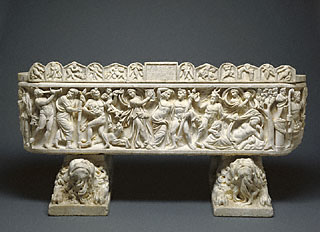• By looking at the configuration and shape of this object, can you tell for what it was used? (The horizontal composition,
lid, and depth of the object can lead us to conclude it is a
sarcophagus.)
• What is going on in the scene on the front of the sarcophagus? (People and creatures are gathered together. Some are
dancing; others are drinking. One creature unveils a female figure under a tree.)
• This is a scene of a
Dionysiac party, culminating in the deity
Pan's discovery of the sleeping
Ariadne. She awakened to a
new life with
Dionysus, the god of wine. Why might an artist choose this scene for a funerary object? (According to Roman religion,
the person inside the sarcophagus would awaken to a new and happy life in the afterworld. Therefore, the depiction of the story of
Ariadne and Dionysus is an appropriate one.)
• The artist depicts a narrative in a very tight compressed horizontal/linear space. What types of modern-day art images does
this remind you of? (Cartoon strips, illustrations, and comic books.)
• The female figure at the bottom of the sarcophagus next to the tree was meant to have the face of the deceased person. This
would have immortalized the person had the carving been finished. What other cultures can you think of that use representations of
individuals on their coffins/sarcophagi? (Egyptian, European, some Asian.) |
The inscription on the lid of this sarcophagus identifies the deceased person, Maconiana Severiana, as being from a senatorial
family. Given the small size of the sarcophagus, Maconiana must have been a child or adolescent.
The front of the sarcophagus shows a dionysiac revel, culminating in the discovery of the sleeping Ariadne, shown lying down on
the right. Abandoned by the Greek hero Theseus on the island of Naxos, Ariadne awakened to a new life with Dionysus, the god of
wine. The goat-legged Pan lifts the veil from her prone figure while satyrs (half-man and half-horse/goat creatures that were followers of the god Dionysus),
maenads, and a panther surround the drunken Dionysus.
The back of the sarcophagus shows another Dionysiac scene of wine making carved in a simpler, flatter style. For the Romans,
Dionysus was associated with the hope of a better afterlife; thus, many sarcophagi show the god and his followers.
Sculpted stone sarcophagi, which came into common use in the second century A.D., could serve to indicate wealth and status.
Since Romans favored certain mythological themes, sarcophagi were often bought ready-made and then customized by the addition
of a portrait of the deceased. The blank face of Ariadne on this sarcophagus should have been carved as a portrait of Maconiana
Severiana. Why it was left blank in this instance is not clear.
|
